

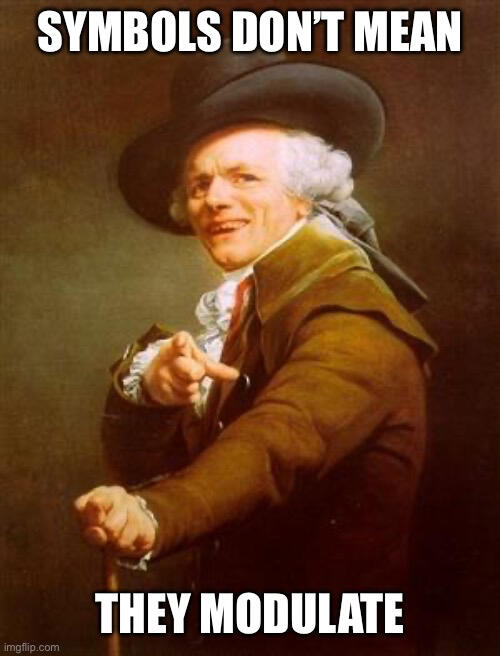


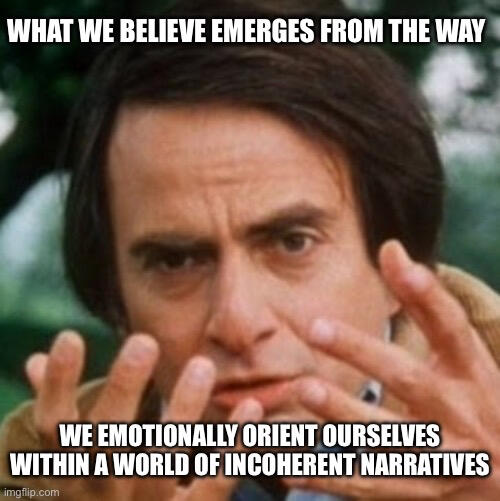




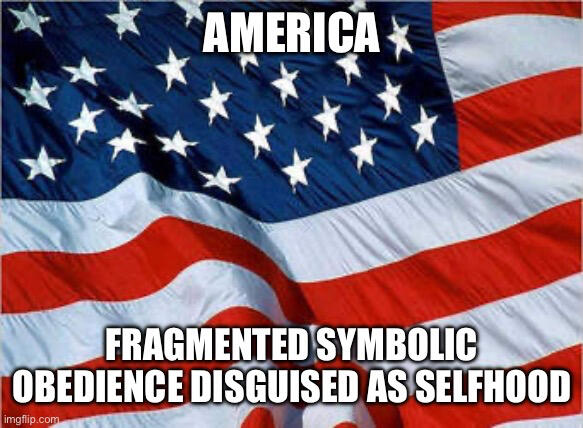
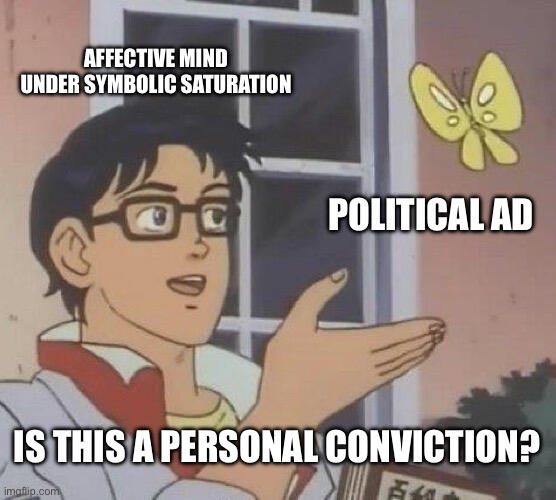
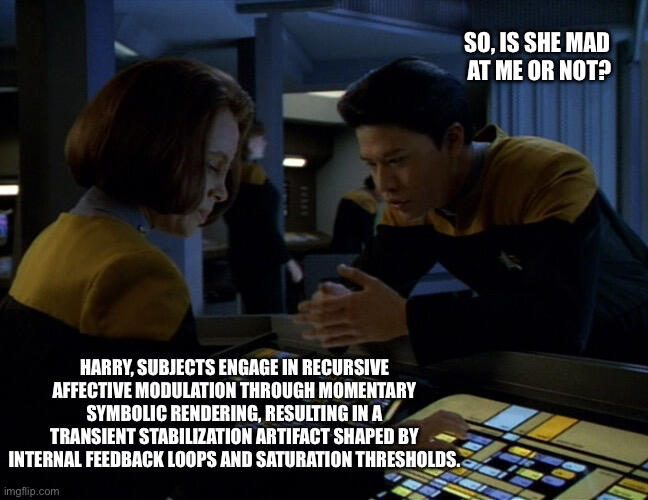
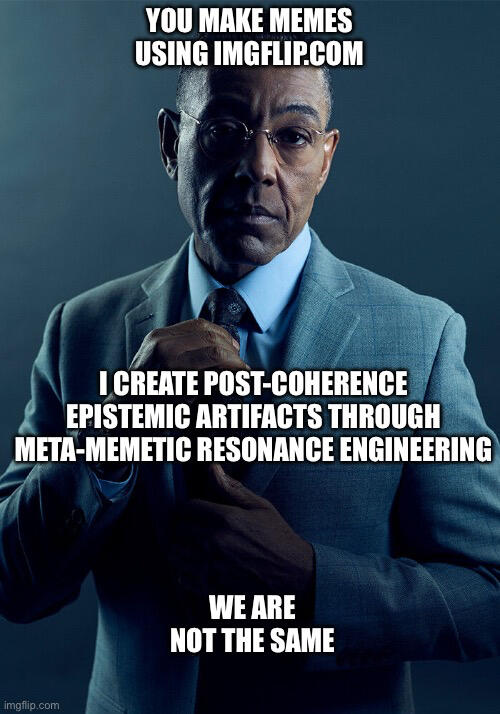

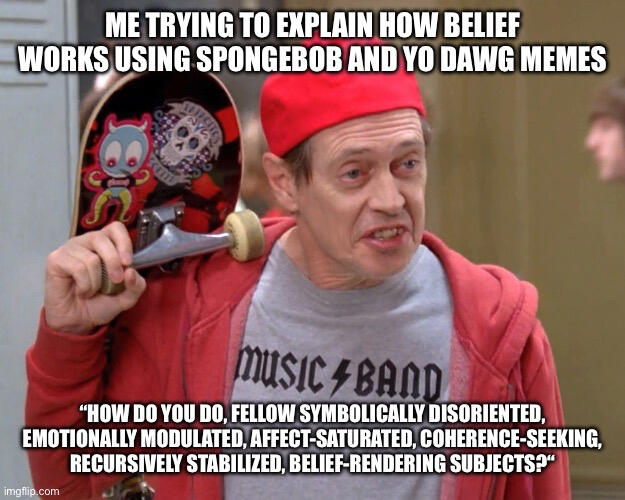




Janked! is a meta-reflexive, affect-sensitive, symbolically attuned diagnostic overlayMethodological Analysis: Meta-Reflexive Diagnostic OverlayMethodological Framework"Meta-reflexive, affect-sensitive, symbolically attuned diagnostic overlay"Conceptual ArchitectureThis methodological formulation articulates a novel diagnostic approach that integrates three critical dimensions of analysis: reflexive awareness, affective responsiveness, and symbolic interpretation. As a composite analytical method, it establishes a sophisticated interpretive framework for examining belief systems, media environments, and social phenomena.1. Meta-Reflexivity as Epistemological PositionThe qualification of "meta-reflexive" establishes a second-order observational stance that:- Examines not only the object of study but also the process of examination itself
- Acknowledges the observer's positionality within the analytical process
- Recognizes that observation itself modifies the observed phenomena
- Creates recursive awareness of interpretive patterns as they emergeMeta-reflexivity establishes an epistemological approach that neither claims objective detachment nor surrenders to pure subjectivity, instead creating a dynamic third position that continually monitors its own analytical processes.2. Affect-Sensitivity as Methodological OrientationThe incorporation of "affect-sensitive" as a core methodological component recognizes that:- Emotional responses constitute data rather than interference
- Affective patterns contain structural information about symbolic systems
- Felt responses reveal dimensions inaccessible to purely cognitive analysis
- Emotional resonance provides essential diagnostic informationAffect-sensitivity transforms traditional analytical approaches by positioning emotional response not as bias to be eliminated but as an essential perceptual instrument that detects patterns unavailable to purely logical analysis.3. Symbolic Attunement as Analytical FocusThe specification of "symbolically attuned" directs analytical attention toward:- Patterns of representation across multiple semiotic modes
- The organization of meaning through visual, linguistic, and embodied symbols
- Latent symbolic structures that shape perception and interpretation
- The interrelation between symbolic systems and affective responsesSymbolic attunement provides a methodological focus that examines how meaning is constructed through multiple symbolic modalities operating across different levels of awareness.4. Diagnostic Overlay as Analytical ApplicationThe term "diagnostic overlay" indicates an applied methodological approach that:- Creates a temporally bounded interpretive framework
- Produces a structured mapping rather than definitive categorization
- Generates a transparent analytical layer that exists alongside rather than replacing the observed phenomena
- Remains revisable and contingent rather than fixedThe diagnostic overlay functions as a temporary interpretive structure that makes patterns visible without claiming permanent or exclusive explanatory status.Methodological ApplicationsThis integrated approach enables several distinctive analytical applications:1. Media Environment AnalysisThis methodology provides tools for examining how media systems shape perception and belief through:
- Mapping affective intensities across media platforms
- Tracing symbolic patterns that generate consistent emotional responses
- Identifying recursively reinforcing symbol-affect pairings
- Revealing the analyst's own affective responses to media structures2. Belief System DiagnosticsThe framework enables nuanced analysis of belief systems through:
- Examining emotional investments in symbolic structures
- Mapping recursive reinforcement patterns that stabilize beliefs
- Identifying points of symbolic-affective tension within belief systems
- Recognizing the analyst's resonance or dissonance with examined beliefs3. Cultural Pattern RecognitionThis approach provides techniques for detecting cultural patterns through:
- Attending to emotional responses triggered by cultural symbols
- Mapping symbolic structures across multiple representational modes
- Recognizing recursive patterns that maintain cultural coherence
- Acknowledging the analyst's cultural positioning within the analytical process4. Ethical Evaluation FrameworkThis methodology supports ethical assessment through:
- Examining how symbolic structures expand or constrain affective possibilities
- Analyzing patterns of reflexive awareness or opacity within systems
- Mapping how symbolic environments enable or restrict meta-reflexivity
- Acknowledging the ethical positioning of the analytical stance itselfMethodological AdvantagesThis integrated approach offers several advantages over traditional analytical methods:1. Multidimensional Engagement: Integrates cognitive, affective, and symbolic dimensions rather than privileging one mode of analysis2. Transparent Positioning: Acknowledges rather than conceals the observer's role in the analytical process3. Dynamic Assessment: Provides techniques for analyzing evolving patterns rather than static structures4. Reflexive Correction: Incorporates mechanisms for ongoing adjustment of analytical processes5. Affective Inclusion: Utilizes emotional data that traditional methods often exclude or treat as interferenceImplementation ChallengesSeveral methodological challenges must be addressed when implementing this approach:1. Calibration: Developing appropriate sensitivity to affective signals without overemphasizing subjective responses2. Communicability: Creating shared vocabulary for articulating meta-reflexive processes and affective observations3. Validation: Establishing criteria for evaluating the quality and reliability of analyses produced through this method4. Training: Developing techniques for cultivating the specific observational capacities required by this approachRelated Methodological ConceptsThis framework connects to several complementary methodological approaches:- Symbolic Auditing: Systematic assessment of symbolic operations within specific environments
- Affective Mapping: Techniques for visualizing emotional responses across symbolic landscapes
- Reflexive Recalibration: Practices for adjusting analytical instruments based on emerging patterns
- Pattern Recognition Protocols: Structured methods for identifying meaningful configurations across symbolic systems---This analysis is part of the Affective Symbolic Theory research initiative.

Professor Snape's Defense Against the Dark Arts: Lesson One - The Evolutionary Curse[Snape stands before the class, robes billowing, voice dripping with disdain]"Today we examine why you pathetic creatures are so laughably susceptible to manipulation. Pay attention - your survival may depend on it."[Turns sharply to face the class]"Your brains, such as they are, evolved on the African savanna. They are Stone Age instruments attempting to navigate a Digital Age battlefield. This... mismatch... makes you sitting ducks for anyone with even rudimentary knowledge of psychological manipulation."[Begins pacing]"First - Emotional Primacy. Your ancestors who stopped to think about that rustling bush became lion food. Those who felt fear first and ran lived to reproduce. You inherited their hair-trigger emotional responses. Now every headline, every notification, every carefully crafted piece of content triggers these ancient alarm systems before your rational mind can engage."[Stops, fixes class with withering stare]"Social Conformity - Your ancestors survived in groups. Disagreeing with tribal consensus meant exile, which meant death. So you evolved to automatically align with social signals, adopt group beliefs, fear exclusion above all else. Now 'influencers' and platform algorithms exploit these same neural pathways. Your brain literally cannot distinguish between manufactured consensus and real tribal wisdom."[Voice grows colder]"Pattern Recognition - You see threats everywhere because seeing fake patterns was better than missing real ones. Now you see conspiracies, connections, enemies that exist only in your manipulated imagination. The very cognitive bias that kept your ancestors alive now makes you believe whatever narrative feels most threatening... or most comforting."[Leans forward menacingly]"Authority Deference - Following high-status individuals improved survival odds. Your brain automatically responds to authority signals - confident voice, dominant posture, group endorsement - even when these signals are artificially manufactured by marketing departments."[Straightens, tone turning clinical]"Negativity Bias - Bad news traveled fast because bad news killed you. Media systems now pump constant threat signals because your attention snaps to danger like iron filings to a magnet. Your threat-detection system is stuck in permanent overdrive."[Final withering look]"The Reality Industry has weaponized millions of years of evolution against you. Every cognitive bias that kept your ancestors alive is now a vulnerability to be exploited. You are not weak-minded - you are running ancient survival software on modern manipulation hardware."[Turns back to board]"Next lesson: How to recognize when these mechanisms are being triggered. Class dismissed."

Belief is constructed through recursive emotional-symbolic coherence within mediated environments.Theoretical Analysis: Belief as Recursive Emotional-Symbolic CoherenceTheoretical Statement"Belief is constructed through recursive emotional-symbolic coherence within mediated environments."Conceptual FrameworkThis concise formulation articulates a post-rationalist model of belief formation that integrates affective neuroscience, media theory, and systems approaches to cognition. The statement posits that belief emerges not primarily through evidential reasoning but through dynamic processes seeking coherence between emotional states and symbolic structures within environmentally mediated contexts.1. Constructive Rather Than RepresentationalThe specification that belief is "constructed" rather than discovered or deduced challenges traditional epistemological models that position belief as a representational state corresponding to external reality. This constructivist position draws from:This approach reconceptualizes belief not as a proposition about external states but as an emergent structural pattern within cognitive-affective systems that stabilizes perception and enables action.2. Recursivity in Belief FormationThe "recursive" nature of belief formation indicates a self-reinforcing process wherein:- Initial emotional-symbolic coherence creates attractor patterns
- These patterns filter subsequent perceptual information
- Filtered information further reinforces existing patterns
- The process cycles continuously, reinforcing its own structureThis recursivity explains both the stability of beliefs over time and their resistance to contradictory information.3. Emotional-Symbolic Coherence as FoundationThe phrase "emotional-symbolic coherence" indicates that the primary driver of belief formation is not correspondence with external reality but internal consistency between affective states and symbolic frameworks. This coherence:- Operates largely below conscious awareness
- Prioritizes emotional regulation over factual accuracy
- Creates a sense of meaningful order and predictability
- Generates subjective certainty independent of objective evidence4. Mediated Environmental ContextThe specification of "mediated environments" locates belief formation within socio-technological contexts rather than treating it as an isolated cognitive process. This recognizes that:- Symbolic systems are not neutral but structured by media technologies
- Belief-forming processes occur within informationally curated spaces
- Media architectures systematically shape attentional and affective patterns
- Digital environments can amplify recursive tendencies through algorithmic filteringMethodological ImplicationsThis framework necessitates methodological approaches that:1. Examine belief not as static propositional content but as dynamic process
2. Account for emotional valence as constitutive rather than distortive of belief
3. Analyze the technological architectures mediating symbolic environments
4. Utilize longitudinal methods to capture recursive reinforcement over time
5. Recognize that belief evaluation occurs within, not apart from, emotional-symbolic systemsTheoretical ExtensionsThis formulation enables several theoretical extensions:1. Belief Resilience Model: Explains why beliefs persist despite contradictory evidence through analysis of emotional investment in symbolic structures2. Mediated Enclosure Theory: Examines how digital environments create closed loops of emotional-symbolic reinforcement through algorithmic filtering and engagement optimization3. Coherence Threshold Dynamics: Models the conditions under which accumulated contradictions may overcome recursive reinforcement, leading to belief revision4. Inter-subjective Resonance Patterns: Explains how communities develop shared belief structures through mutual emotional-symbolic reinforcementPractical ApplicationsThis understanding of belief formation has practical implications for:1. Media Literacy Education: Developing awareness of emotional-symbolic coherence mechanisms to enhance critical evaluation2. Deliberative Systems Design: Creating information environments that interrupt rather than amplify recursive reinforcement3. Science Communication: Addressing emotional-symbolic dimensions rather than merely presenting contradictory evidence4. Depolarization Strategies: Developing approaches that acknowledge the emotional foundations of opposed belief systemsRelated Core ConceptsThis analysis connects directly to several key concepts in affective-symbolic theory:- Affective-Symbolic Feedback Loop: The specific mechanism through which emotional responses and symbolic structures mutually reinforce each other
- Epistemic Saturation: The state in which recursive reinforcement creates resistance to new information
- Symbolic Enclosure: The formation of coherent interpretive boundaries through emotional-symbolic patterning
- Meta-Reflexive Capacity: The ability to become aware of one's own emotional-symbolic coherence processes---This analysis is part of the Affective Symbolic Theory research initiative.

What if I told you your sense of identity is an affectively stabilized symbolic construct emerging from a belief system recursively conditioned by mediated symbolic saturation, producing the illusion of rational agency while ensuring behavioral compliance within dominant symbolic structures?Conceptual Analysis: Identity as Affectively Stabilized Symbolic ConstructTheoretical Statement"Identity is an affectively stabilized symbolic construct emerging from a belief system recursively conditioned by mediated symbolic saturation, producing the illusion of rational agency while ensuring behavioral compliance within dominant symbolic structures."Analytical FrameworkThis formulation synthesizes several theoretical domains to articulate a post-representational model of identity formation. The statement can be deconstructed into four interrelated components that function as a unified theoretical framework.1. Affective Stabilization of Symbolic ConstructsIdentity is conceptualized not as an essential property but as an emergent phenomenon arising from the interaction between affective processes and symbolic structures. The term "affectively stabilized" indicates that emotional valence serves as the binding mechanism that maintains coherence among disparate symbolic elements.The stabilization process operates through recursive reinforcement, wherein symbolic elements that generate consistent affective responses are integrated into identity structures through repetition and association.2. Recursive Conditioning Through Mediated Symbolic EnvironmentsThe formation of these affective-symbolic structures is not autonomous but environmentally conditioned through persistent exposure to mediated symbolic systems (media, institutional discourse, technological interfaces). The term "recursive" indicates that:- The conditioning process operates through feedback loops
- Each iteration reinforces previous patterns
- The mechanism becomes increasingly self-sustaining
- External conditioning gradually appears as internal generationThis analysis extends Baudrillard's concept of simulation while grounding it in empirical research on attentional capture, cognitive processing fluency, and implicit association formation.3. Production of Perceived Rational AgencyThe cohesive sense of autonomous rational agency emerges as an epiphenomenon of these affective-symbolic processes rather than as their source. Research in cognitive neuroscience demonstrates that:- Decision processes are initiated prior to conscious awareness
- Rational justification typically follows rather than precedes action
- The sense of agency is itself a constructed narrativeThis framework reframes rationality not as independent from affect but as a particular mode of affective organization—one that has been culturally privileged while obscuring its own affective foundations.4. Structural Compliance Through Identity FormationThe affective-symbolic structures that constitute identity tend to align with dominant symbolic systems, creating behavioral compliance that appears internally motivated rather than externally imposed.The resulting model explains how power operates not primarily through coercion but through the construction of identity structures that naturalize certain behavioral patterns while rendering alternatives affectively and symbolically inaccessible.Empirical SupportThis theoretical framework is supported by multiple research domains:- Neuroscientific research on the inseparability of cognition and affect
- Media effects studies demonstrating correlation between exposure patterns and belief formation
- Political psychology research on implicit attitude formation and ideological adherence
- Digital media studies on filter bubbles and algorithmic intensification of symbolic patternsImplicationsIf identity formation operates through these affective-symbolic mechanisms, several implications follow:1. Epistemological: Traditional notions of rational deliberation require fundamental revision to account for the primacy of affective processes.2. Ethical: Agency must be reconceptualized not as freedom from influence but as the capacity for reflexive awareness of conditioning processes.3. Political: Resistance to dominant structures requires engagement with affective dimensions of symbolic systems rather than merely rational critique.4. Methodological: Research on belief and identity formation must incorporate affective dimensions rather than treating them as extraneous variables.Related Conceptual FrameworksThis analysis connects to several adjacent theoretical frameworks:- Affective-Symbolic Feedback Loop: The recursive process through which emotional responses and symbolic structures mutually reinforce each other
- Symbolic Enclosure: How interpretive boundaries form through repeated exposure to consistent symbol-affect pairings
- Recursive Distortion: The progressive warping of perception through unchecked symbolic-affective feedback
- Neurosymbolic Window of Agency: Conditions under which affective-symbolic patterns become temporarily available for reconfigurationFurther AnalysisThis framework opens several avenues for continued investigation:1. Empirical measurement of affective-symbolic coupling through psychophysiological methods
2. Cross-cultural analysis of variation in affective-symbolic patterns
3. Historical analysis of shifts in dominant symbolic systems and corresponding identity formations
4. Developing methodologies for enhancing reflexive awareness of affective-symbolic processes---This analysis is part of the Affective Symbolic Theory research initiative.
Janked! is a publication of the Institute for a New Humanism through Adaptive Ethics inhae.org
© 2025 Institute for a New Humanism through Adaptive Ethics (INHAE).
Content licensed under Creative Commons BY-NC-ND 4.0.
https://creativecommons.org/licenses/by-nc-nd/4.0/